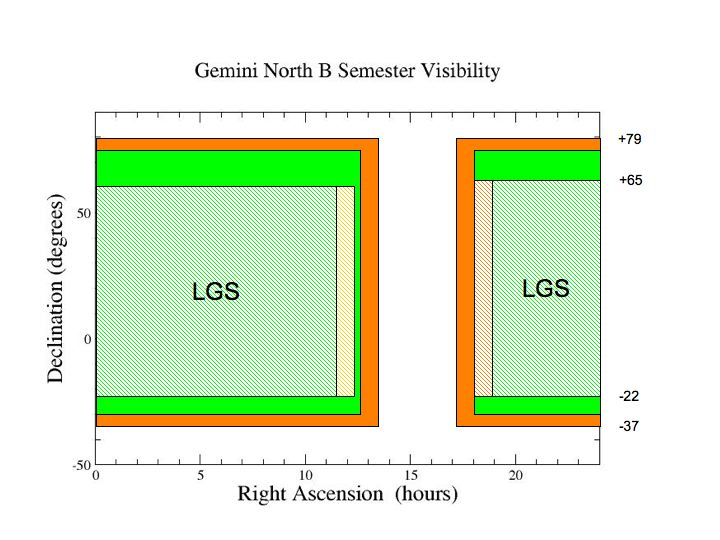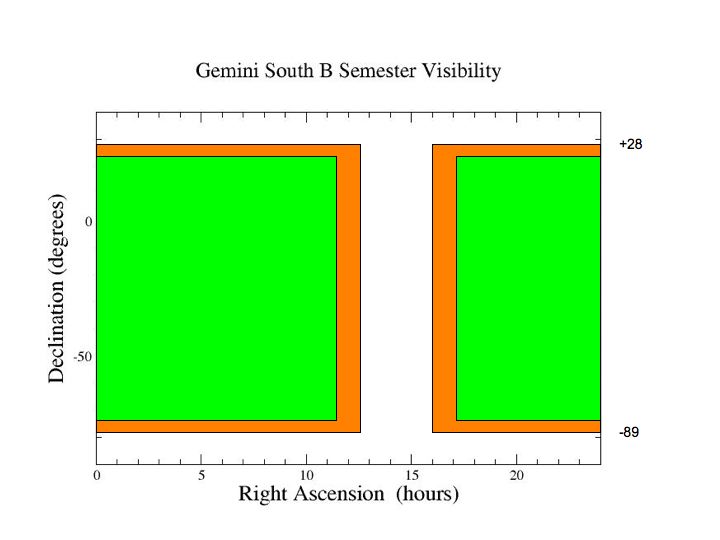Instrument Availability and Target Accessibility: 2008B
You are here
This page provides best estimates, at the time of the Call for Proposals, of instrument availability and corresponding target (RA, dec) restrictions for 2008B.
General
Instrument Changes: As there are more instruments than the number of available ports on each
telescope, instrument swaps will be required. Therefore not all instruments will be available for the entire semester.
However, whenever possible instrument swaps will be scheduled to
minimize impact on the queue. In other words, instrument swaps will be driven
by demand as much as possible and so the final schedule will not be
made until after the 2008B programs are known. Nevertheless, it
may be the case that certain targets or entire programs will not be
feasible once the final schedule is determined, at ITAC or thereafter.
If an instrument is requested for less than 6% of the Bands 1+2 time, the Observatory
reserves the right to limit the RA range available to programs, or to not schedule the instrument.
During classical runs, no instrument changes on the Instrument Support Structure are permitted.
Gemini North
At Gemini North, NIRI and GMOS-N will remain on their side-looking ports and be available throughout the semester. NIFS and Michelle share the up-looking port. It is expected that NIFS will be available from August to September, and from mid-December to the end of January. It is expected that Michelle will be available between late-September and mid-December. Approximately week-long maintenance engineering will most likely occur during the semester, but this should not impact queue observing. In summary, there are no special restrictions on target availability for GMOS-N, NIFS, NIRI or Michelle, apart from sky visibility described below.
Observations requiring the Laser Guide Star (LGS) system are restricted by the limitation that the LGS must be used at or above 40 degrees elevation. How this translates into RA and dec restrictions is indicated in the figure below. Standard ToO LGS observations are allowed; however target lists are generated for approval by Space Command approximately a week before each LGS run, using only "ready" observations. Therefore, while observations must be defined by the usual phase II deadline, any additions or alterations must be in place by the LGS target preparation dates. We do offer limited LGS observations of Band 1 and 2 ToOs that are triggered less than a week before, or during, an LGS run. The observations must be made during a planned LGS run at the telescope. Also, only two such targets (for all programs) can be observed during any typically week-long LGS run, and only one such target (for all programs) can be observed on any given night. All effort will be made to approve and observe a target within 24 hours, however this cannot be guaranteed, and the observation may occur two or three nights after the trigger is made.
Figure 1 displays the accessibility of targets as a function of RA
(horizontal axis) and Declination (vertical axis) at Gemini North for
the 2008B semester. Green and orange regions offer easy and restricted access
during the semester, respectively.
The smaller hatched areas indicate the more restricted LGS regions.
Although target elevation does not follow a strictly rectangular RA/dec region,
these are the limits at which the Phase 1 Tool will issue warning and error messages.
Proposers with targets close to the limits are advised to consider
carefully the amount of time needed on the
source, the observing conditions required and the maximum airmass acceptable for the observation.
Targets outside of these regions should not be submitted
in 2008B, unless the observations are extremely short and have relaxed observing constraints.

Figure 1: Target accessibility at Gemini North during semester 2008B. Green and orange regions offer easy and restricted access
during the semester, respectively. The smaller hatched areas indicate the more restricted LGS regions. Targets outside the orange region should not be submitted in 2008B.
Gemini South
At Gemini South, GMOS-S, Phoenix and NICI be mounted on side-ports, and T-ReCS on the up-looking port, throughout most of the semester. Scheduling of the Flamingos-2 and MCAO/GSAOI commissioning is uncertain at this time; Flamingos-2 may be swapped with GMOS-S and/or T-ReCS, and GSAOI with Phoenix and/or NICI. Approximately week-long maintenance engineering will most likely occur during the semester, but this should not impact queue observing. No RA restrictions on any of the instruments are envisioned at this time, apart from sky visibility described below.
Figure 2 displays the accessibility
of targets as a function of RA (horizontal axis) and Declination
(vertical axis) at Gemini South for the 2008B semester.
Green and orange regions offer easy and restricted access
during the semester, respectively. Targets outside of these regions should not be submitted
in 2008B, unless the observations are extremely short and have relaxed observing constraints.
Proposers with targets close to the limits are advised to consider
carefully the amount of time needed on the
source, the observing conditions required and the maximum airmass acceptable for the observation.

Figure 2: Target accessibility at Gemini South during semester 2008A.Green and orange regions offer easy and restricted access during the semester, respectively. Targets outside the orange region should not be submitted in 2008B.
Last update 19 February, 2008; Sandy Leggett
